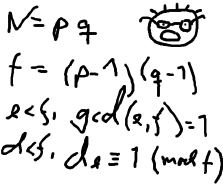POJ 2635-The Embarrassed Cryptographer(高精度求模+同余模定理)
来源:互联网 发布:韩顺平java视频有用吗 编辑:程序博客网 时间:2024/05/16 16:23
The Embarrassed Cryptographer
Time Limit:2000MS Memory Limit:65536KB 64bit IO Format:%I64d & %I64uAppoint description:
Description
 The young and very promising cryptographer Odd Even has implemented the security module of a large system with thousands of users, which is now in use in his company. The cryptographic keys are created from the product of two primes, and are believed to be secure because there is no known method for factoring such a product effectively.
The young and very promising cryptographer Odd Even has implemented the security module of a large system with thousands of users, which is now in use in his company. The cryptographic keys are created from the product of two primes, and are believed to be secure because there is no known method for factoring such a product effectively. What Odd Even did not think of, was that both factors in a key should be large, not just their product. It is now possible that some of the users of the system have weak keys. In a desperate attempt not to be fired, Odd Even secretly goes through all the users keys, to check if they are strong enough. He uses his very poweful Atari, and is especially careful when checking his boss' key.
Input
The input consists of no more than 20 test cases. Each test case is a line with the integers 4 <= K <= 10 100 and 2 <= L <= 10 6. K is the key itself, a product of two primes. L is the wanted minimum size of the factors in the key. The input set is terminated by a case where K = 0 and L = 0.
Output
For each number K, if one of its factors are strictly less than the required L, your program should output "BAD p", where p is the smallest factor in K. Otherwise, it should output "GOOD". Cases should be separated by a line-break.
Sample Input
143 10143 20667 20667 302573 302573 400 0
Sample Output
GOODBAD 11GOODBAD 23GOODBAD 31
题意:给定一个大数str,str是两个大素数的乘积的值,再给定一个int内的数n,问这两个大素数中最小的一个是否小于n,如果小于则输出GOOD,否则输出BAD和两个素数中最小的。
思路:先用素数筛把小于1100000的素数都找出来。然后把str转化为一堆千进制。对于每一个千进制,把i从2到n遍历一遍即可。
PS:然而学习了一下高精度求模,原来可以这么搞,Orz。
然而中学生的高精度取模也是醉了点击打开链接
高精度求模。
主要利用qk数组和同余模定理。
例如要验证123是否被3整除,只需求模124%3
但当123是一个大数时,就不能直接求,只能通过同余模定理对大数“分块”间接求模
具体做法是:
先求1%3 = 1
再求(1*10+2)%3 = 0
再求 (0*10+4)% 3 = 1
那么就间接得到124%3=1,这是显然正确的
而且不难发现, (1*10+2)*10+4 = 124
这是在10进制下的做法,千进制也同理,*10改为*1000就可以了。
#include <stdio.h>#include <math.h>#include <string.h>#include <stdlib.h>#include <iostream>#include <sstream>#include <algorithm>#include <set>#include <queue>#include <stack>#include <map>using namespace std;typedef long long LL;const int inf=0x3f3f3f3f;const double eps=1e-10;const double pi= acos(-1.0);const int MAXN=1e6+10;int prime[MAXN]={2,3,5};int qk[1010];//素数筛void is_prime(){ int i,j; int flag=0; int gcd=2; int k=3; for(i=7;i<MAXN;i+=gcd){ flag=0; gcd=6-gcd; for(j=0;prime[j]*prime[j]<=i;j++){ if(i%prime[j]==0){ flag=1; break; } } if(!flag) prime[k++]=i; }}//高精度K对p求模,因数检查(整除)int mod(int *K,int m,int len){ int res=0; for(int i=len-1;i>=0;i--)//千进制K是逆序存放,因为计算起来方便 res=(res*1000+K[i])%m; //同余模定理 if(!res) return 0; //K被整除 else return 1;}int main(){ char str[1010]; int n,i,j; int flag; is_prime(); while(~scanf("%s %d",str,&n)){ if(str[0]=='0'&&n==0) break; memset(qk,0,sizeof(qk)); int len=strlen(str); int ii=0; for(int i=len-1;i>=0;i-=3){//把str转换为千进制qk,其中qk局部顺序,全局倒序 //如str=1234567=[ 1][234][567] ,则qk=[567][234][1 ] if(i>=2) qk[ii]=(str[i]-'0')+(str[i-1]-'0')*10+(str[i-2]-'0')*100; else if(i==1) qk[ii]=(str[i]-'0')+(str[i-1]-'0')*10; else if(i==0) qk[ii]=(str[i]-'0'); ii++; } int len_qk=(len+2)/3; int qMin=0;//能整除qk且比n小的在prime中的最小素数下标 flag=1; while(prime[qMin]<n){//枚举prime中比L小的素数 if(!mod(qk,prime[qMin],len_qk)){ flag=0; printf("BAD %d\n",prime[qMin]); break; } qMin++; } if(flag) puts("GOOD"); } return 0;} 1 0
- POJ 2635 The Embarrassed Cryptographer [高精度求余+同余模定理]【数论】
- The Embarrassed Cryptographer POJ 2635 数论之高精度求模(同余模定理+千进制)
- POJ 2635-The Embarrassed Cryptographer(高精度求模+同余模定理)
- POJ 2635 The Embarrassed Cryptographer【数论,千进制,高精度求模+同余模定理】
- POJ 2635 The Embarrassed Cryptographer(高精度取模 + 同余模定理)
- POJ 2635 The Embarrassed Cryptographer(素数筛+高精度求模+同余模)
- poj 2635 The Embarrassed Cryptographer(素数筛 + 同余模定理)
- poj 2635 The Embarrassed Cryptographer(同余模定理的应用)
- (POJ2635)The Embarrassed Cryptographer <高精度求模(千进制表示) + 同余模定理 + 素数打表>
- poj 2635 The Embarrassed Cryptographer(同余模运算)
- poj The Embarrassed Cryptographer(大数取模)(同余模定理)
- [ACM] POJ 2635 The Embarrassed Cryptographer (同余定理,素数打表)
- poj 2635 The Embarrassed Cryptographer (同余定理,筛选法)
- poj2635The Embarrassed Cryptographer(同余模+素数筛选+高精度求模)
- POJ 2635 The Embarrassed Cryptographer (同余线性方程+素数筛)
- POJ 2635 The Embarrassed Cryptographer (同余问题)
- POJ 2635 The Embarrassed Cryptographer 线性筛+高精度取模
- POJ 2635 The Embarrassed Cryptographer(千进制 高精度取模)
- destoon手机版去版权
- intellij ctrl+alt+shift+u
- JavaScript-回调函数
- 我是菜鸟:Java泛型学习
- android socket readline()方法读不到值的问题
- POJ 2635-The Embarrassed Cryptographer(高精度求模+同余模定理)
- HDU 2053
- 贪心算法基础(二)
- iOS:Compile error List(二)--Special
- Lowest Common Ancestor(LCA)
- 密码学_chinese hacker
- Java Servlet学习笔记(四)Servlet客户端Http请求
- Java基础知识之IO(1)
- Machine Learning多变量梯度下降


